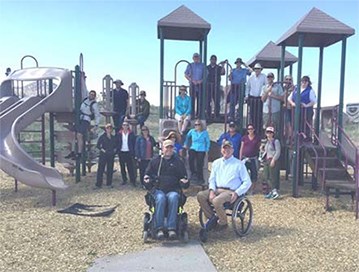Last updated: May 16, 2018
Article
Striving to Improve Accessibility in Our Parks

NPS Photo
Providing access to our national parks is important, and planning, designing, constructing, and maintaining accessible environments and experiences is a continual challenge for those who work with and within parks. The National Park Service (NPS) strives to be a beacon of equality, where everyone is encouraged and able to share and enjoy park services, activities, and programs. Whether it's watching a colorful sunset at the Grand Canyon National Park or gaping in awe as Old Faithful erupts at Yellowstone National Park, experiences like these must be accessible for all visitors and preserved for future generations.
The Denver Service Center-Planning Division is currently involved in a number of accessibility planning projects, including accessibility self-evaluation and transition plans, targeted accessibility improvement projects, and various other accessibility components of site planning and visitor use projects. To further their communal knowledge, some staff has also attended accessibility training sessions, such as the National Americans With Disabilities Act Symposiums. However, recognizing the limits of their knowledge and experience as well as those in other divisions, particularly regarding accessibility in outdoor environments, the division sought assistance from the US Access Board, the agency tasked with writing accessibility guidelines and standards for the built environment, transportation, communication, and information technology.
A two-day training session was held April 18-19 in Denver with Bill Botten of the US Access Board. Bill is an expert in access issues related to recreation facilities and outdoor developed areas, and he provides technical assistance to the building and construction industry, state and federal agencies, and consumers with disabilities. About 25 NPS employees from the Denver Service Center and Intermountain Region attended.
Day 1 was held at the Alameda building, where Bill provided an overview of the Architectural Barriers Act and presented detailed descriptions of each chapter of the standards, with a heavy focus on Chapter 10: Recreation Facilities. Day 2 was held at Bear Creek Lake Park, where Bill led participants through an on-site review of accessibility requirements and best practices for parking, boat launches, fishing piers, picnic facilities, camping facilities, restrooms, and playgrounds. Feedback from training participants was overwhelmingly positive, and many commented on the quality of the training and instructor, improved understanding of accessibility for outdoor environments, and new opportunities to share accessibility challenges and solutions across all divisions.
Takeaways from the training will be used to improve accessibility products at parks and training of park staff. For more information about how the NPS is striving to improve accessibility at parks, please review All in! Accessibility in the National Park Service (pdf) 2015-2020.
